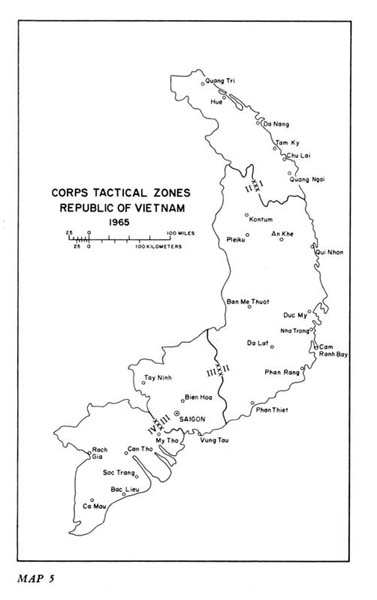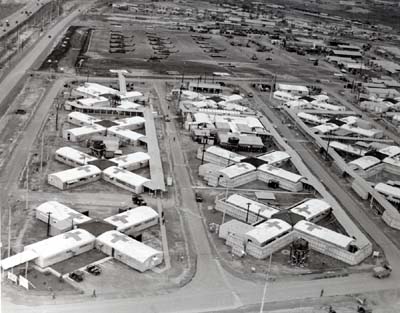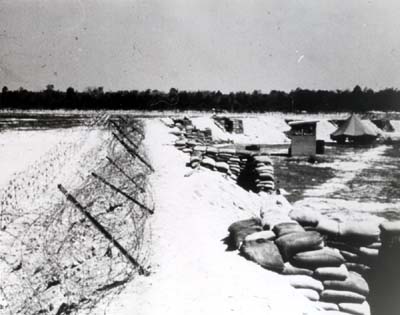
MAP 5
CHAPTER VI
Engineer Group Deployment
In evaluating the logistical and tactical requirements for engineer support for the U.S. Army in Vietnam, certain geographical and tactical factors had to be considered. The physical geography of the country, a long narrow land mass bordered on one side by Cambodia and Laos and on the other by the sea, and the insecure land lines of communication dictated a logistical concept oriented from the sea toward the Cambodian aid Laotian borders. Because the Viet Cong were able to interrupt continuously traffic along the highway network, north-south lines of communication were restricted mainly to sea and air. The country was divided into four areas, or tactical zones, which required semiautonomous support: I Corps, the northernmost sector of South Vietnam, in which the U.S. Navy retained initial responsibility for engineer support; II Corps, which contained the two major ports of Cam Ranh and Qui Nhon; and III and IV Corps, which for initial engineer support purposes were grouped as one. (Map 5)
In 1965 most combat consisted of guerrilla activity or small unit engagements. Fighting could and did erupt anywhere and at any time. Knowing that isolated inland locations were vulnerable, commanders placed newly arriving engineer units at strategic points along the coast of South Vietnam to provide maximum support during the first months of the buildup. From the time the first engineer units reached Vietnam, every effort was made to prepare for the tremendous influx of U.S. military forces which would follow.
The most immediate need for combat and support engineers existed in northern II Corps where enemy forces were making a concerted effort to cut the country in two along the Pleiku-An Khe-Qui Nhon axis. In response to the urgency of the situation in II Corps Tactical Zone, the advance parties of the 70th Engineer Battalion (Combat) and the 937th Engineer Group headquarters arrived at the coastal city of Qui Nhon on 16 August 1965 to prepare for the main body of their troops that would arrive a week later. The 70th, which arrived at Qui Nhon on 23 August, was the first engineer combat battalion in the Republic of Vietnam.
[75]
[76]
The arrival of the 70th Battalion and the 937th headquarters significantly changed the engineer situation in II Corps Tactical Zone. Both organizations were experienced, having been in fully trained status for some time at Fort Campbell, Kentucky, before their deployment to Southeast Asia. Their immediate mission was to begin preparations for adequate logistical and tactical support of the 1st Cavalry Division (Airmobile), whose arrival was imminent.
The 84th Engineer Battalion (Construction) minus Company D had been in Qui Nhon since 11 June as part of the initial deployment of engineer forces with the 35th Engineer Group and had been working since then on the preliminary aspects of depot construction and improvement of Qui Nhon's port. A provincial capital and coastal city, Qui Nhon is located at the eastern terminus of National Route 19, which runs west to Pleiku and the Darlac Plateau. Although Qui Nhon had only a limited port capacity, it possessed a reasonable network of streets and roads for moving supplies as well as available land that was suitable for military facilities. The city's location made it a gateway to the northern section of II Corps Tactical Zone. The 937th assumed the responsibility for building into the quiet city an operating logistics base. Accumulating equipment for the many construction projects, however, had to be paced to the off-loading of engineer items by shipto-shore shuttle. The advance party of the 70th Battalion had been fortunate enough to meet the ships carrying the battalion's equipment, and by the time the troops of the main body crossed the beach their equipment was ready and waiting. Drivers went immediately to their vehicles and the battalion moved directly to its base camp on the outskirts of the city. After the 937th Group had moved ashore and become operational, it assumed command, under the 1st Logistical Command, of the 84th (-) and 70th Battalions.
The 937th's most immediate task was the preparation of a cantonment site for the 1st Cavalry Division. The 70th Battalion, under cover of the 1st Brigade, 101st Airborne Division, moved forty kilometers over Route 19 to An Khe where, under the planning guidance of the 8th Engineer Battalion of the 1st Cavalry Division, it began construction of the base camp. A two-lane access road, 1.3 miles long, had to be constructed from Route 19 through the jungle of the An Khe valley in order to get men and equipment into the area to be developed. As was the case in most road building operations in South Vietnam, the engineers first had to find a large enough rock deposit and develop a quarry to produce the crushed rock necessary for a road foundation. Six thousand five-ton truckloads of fill were eventually hauled in for the access road. At the
[77]
site preliminary activities included clearing, stripping, and grading nearly a million square yards of land. The advance party of the division under the direction of the assistant division commander, Brigadier General John M. Wright, Jr., hired hundreds of local Vietnamese to clear the land to topsoil level with the objective of retaining sod as permanent protection against the downwash of helicopter blades. The 70th worked meanwhile on a circumferential road for access to each assigned bivouac location.
The 70th Battalion had quickly established itself as the workhorse of the 937th Group. While it was providing direct engineer support for the 1st Cavalry, it was given the task of constructing bridges, roads, helipads, hospitals, guard towers, ammunition storage areas, administration buildings, and a 20,000-man cantonment. Lighting, water, and base security were also provided by engineer troops at An Khe. Throughout its logistical support mission the 70th maintained its tactical posture. On several occasions the engineer troops served as either the combat reaction force for the divisional support brigade defending the An Khe base camp or as part of the perimeter defense force.
In Qui Nhon the other major component of the 937th, the 84th Engineer Battalion (minus Company D) was encountering a problem that became all too common among engineer units in Vietnam. In the course of expanding the logistical facilities at the port of Qui Nhon, the 84th discovered that many of the prefabricated buildings, which were to be used widely in Vietnam, had arrived without some of the necessary construction components. The battalion was able to improvise and fabricate locally many of the missing items, but not without added costs and delays. Work schedules ran around the clock in an effort to keep pace with the everincreasing demands; however, the theater-wide lack of construction materials and shortages of repair parts for engineer equipment plagued the engineers and caused construction to lag behind overambitious schedules. Incoming units bolstered the manpower of the 937th, but delays in the delivery of necessary equipment and materials limited the effectiveness of the new troops.
The lack of port capacity in Vietnam in 1965 was perhaps the most acute problem during the influx of American forces. Vessels carrying engineer equipment, supplies, and construction material often waited offshore for weeks to unload their cargoes while construction projects languished for lack of materials.
The 19th Engineer Battalion (Combat) arrived at Qui Nhon from Fort Meade, Maryland, on 2 September at almost the same time as elements of the 1st Calvary Division (Airmobile) landed. In the face of priorities for tactical units, the engineer equipment
[78]
met delays in offloading The battalion could not contribute fully to the construction effort until 5 November when it undertook the assigned construction of a major aviation facility twelve miles west of the city. Within one hundred days the combat battalion constructed a macadam heliport in the shape of a Christmas tree and capable of supporting fifty UH-1 (Huey) helicopters. A maintenance area and the basic living facilities for two aviation companies were included in the heliport.
On 26 October, after deployment from Fort Gordon, Georgia, the 299th Engineer Battalion (Combat) landed at Qui Nhon. As in the case of the 19th, delays in the arrival and unloading of equipment prevented the battalion from becoming operational until it had been in Vietnam for nearly a month. In November the 299th began construction of a permanent ammunition storage area near Qui Nhon, at the same time expanding and upgrading the road network in and around Qui Nhon. By Christmas of 1965 Qui Nhon was providing a base of logistic support for the tactical forces operating in northern II Corps.
In the southern part of South Vietnam in the III Corps Tactical Zone around Saigon, there was a sharp need for engineer troops by the fall of 1965. On 15 September 1965 Headquarters, U.S. Army, Vietnam, approved a diversion of the 46th Engineer Battalion (Construction), en route to Vietnam from Fort Leonard Wood, Missouri, from Qui Nhon to Vung Tau. When the 46th arrived at Vung Tau, a shallow-draft port approximately thirty-five miles southeast of Saigon, it picked up Company D of the 84th Engineer Battalion. Later, when the main body of the 46th Battalion moved on to establish its base camp at Long Binh, D Company of the 46th was transferred to the 84th Battalion at Qui Nhon to replace the 84th's D Company, which had earlier been diverted to Vung Tau.
On 16 October D Company of the 84th Battalion was redesignated D Company of the 46th and continued its work on the logistical complex and port at Vung Tau. As soon as the 46th became operational it was made a subordinate unit of Headquarters, 18th Engineer Brigade, which had only recently arrived in Vietnam and established itself in the Saigon area. This initial command relationship lasted for only three weeks, however. The headquarters of the 159th Engineer Group arrived in Vietnam from Fort Bragg on 30 September and was assigned control of all nondivisional engineer operations in the III and IV Corps areas.
During the late summer of 1965 at Fort Bragg, the 159th had been rebuilt after providing most of the men for the 18th Brigade headquarters. Upon its arrival in Vietnam, headquarters for the 159th was established at Long Binh just fifteen miles northeast
[79]

THE 93D EVACUATION HOSPITAL AT LONG BINH.
In an advanced state of construction in the spring of 1966 and of unique local
design,
this hospital had revetments around critical wards and on two sides of helicopter
barking stands. Blackened area was treated with dust palliative.
of Saigon in a once cleared area now overgrown with scrub jungle. Starting with a work force consisting only of the 46th Engineer Battalion, the 159th soon grew to include three battalions and two separate companies. The expansion of its command brought a corresponding expansion of tasks as the 159th began construction work at Di An, Lai Khe, and Phu Loi, base camps of elements of the newly arrived 1st Infantry Division. Members of the 159th also stretched to provide direct support to the 173d Airborne Brigade at Bien Hoa and the 1st Logistical Command at Long Binh. As directed by the engineer brigade commander, initial construction concentrated on providing a minimum of living quarters in the base camps of the various combat units and on hospital and logistics construction necessary to support tactical operations.
The first major project of the 46th Engineer Battalion was the construction of the 93d Evacuation Hospital at Long Binh. This 400-bed hospital was to consist of sixty vertical-wall quonset huts
[80]

PERIMETER DEFENSE OF 168TH ENGINEER BATTALION CAMP NEAR DI AN
withstood a number of attacks by Viet Cong from the nearby woods.
(a circular arch roof, metal sides closed on both ends) on concrete floor slabs. The structures were arranged in X-shaped clusters of four with a roofed center square portion used as a nursing station to serve the four wards. Some forty-five days after ground was broken, the hospital was ready for patients. During the same period elements of the 46th also constructed a tactical operations center at DI An for the 1st Infantry Division and tropical buildings for the command flight detachment at Tan Son Nhut and began construction on what eventually became the largest ammunition storage area in Vietnam at Long Binh.
At Vung Tau, what had been Company D of the 46th Engineer Battalion was redesignated by Headquarters, 18th Engineer Brigade, as Company D of the 84th Engineer Battalion. Before the actual Company D of the 46th arrived in October, the decision had been made to have that unit proceed to Qui Nhon to join the 84th, thereby averting any loss in the continuity of operations in the Vung Tau area. Personnel rosters and property books were exchanged between the two battalions and the newly designated Company D, 46th Engineer Battalion, continued its previous operations. Significant progress was being made by the 46th in preparing the port at Vung Tau to handle the debarkation of men and equipment throughout the first year of the U.S. troop buildup in Vietnam.
[81]
[82]
On 2 November 1965 the 588th Engineer Battalion (Combat) from Fort Lee, Virginia, arrived at Ving Tau on board the USNS Upshur and immediately moved inland to its staging area near Bien Hoa. Various elements of this battalion were promptly dispatched to assist the 46th with construction projects already in progress. The last battalion to join the 159th Group in 1965 was the 168th Engineer Battalion (Combat) from Fort Polk, Louisiana. The 168th debarked on 27 November at Vung Tau, which was becoming a major port of entry for American forces. In mid-December, after the battalion had moved inland and become operational at Long Binh, its headquarters and Company A went to DI An to assume responsibility for construction at the base camp of the headquarters and support brigade of the 1st Infantry Division. The remaining elements of the battalion relieved parts of the 46th Battalion in support of the 1st Division's 3d Brigade at Lai Khe and supplemented the construction work of the 46th Engineers at Long Binh.
The problems encountered by the 159th Engineer Group during the initial phases of its operation in the south matched substantially those experienced by the groups farther north. Shortages of materials slowed construction while the continuous influx of U.S. forces increased the demand for facilities. The inadequacy of the system for supplying repair parts caused essential pieces of engineer equipment to be deadlined for long intervals. The oppressive heat and seemingly omnipresent enemy created their own measure of discomfort and anxiety for the engineers who had to labor long hours. Despite adversity, the engineers made steady progress and by year's end construction was taking place at the maximum pace material and equipment resources would allow.
By Christmas of 1965 U.S. Army engineer forces in Vietnam had grown in eight months from less than one hundred to over seven thousand, and many thousands more were to follow. (Map 6)
[83]
Go To:
Return to the Table of Contents